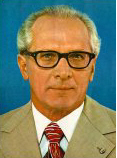| Germany Table of Contents
 Ulbricht's successor in East Germany was Erich Honecker. Born in 1913
in the Saarland, Honecker joined the Communist Party of Germany
(Kommunistische Partei Deutschlands--KPD) in 1929. As a full-time
functionary of the party, he continued his work in the underground
movement after Hitler came to power in 1933 and until arrested by the
Nazis in 1935. Imprisoned until the end of World War II, Honecker
resumed his career in 1945 as a leading KPD functionary, becoming
Ulbricht's assistant on the latter's return to Germany from the Soviet
Union in 1945. From 1946 to 1955, Honecker served as chairman of the
youth organization, the Free German Youth (Freie Deutsche Jugend--FDJ).
He became a member of the SED Politburo in 1958. As secretary for
security matters of the SED Central Committee, Honecker was directly
responsible for the building of the Berlin Wall in 1961. When Ulbricht
was removed from power in 1971, Honecker succeeded him in his party
functions and became chief of the SED. Honecker was head of state of the
GDR from 1976 until his resignation in 1989. After his fall from power,
Honecker found refuge in the Embassy of Chile in Moscow until his
extradition to Berlin in 1992, where he was brought to trial. He was
released from custody in 1993 for health reasons and went to Chile,
where he died in 1994. Although less rigid than Ulbricht, as evidenced
by his willingness to sign agreements with the West that opened the GDR
somewhat and made the lives of its citizens easier, Honecker remained a
convinced communist until his death. Ulbricht's successor in East Germany was Erich Honecker. Born in 1913
in the Saarland, Honecker joined the Communist Party of Germany
(Kommunistische Partei Deutschlands--KPD) in 1929. As a full-time
functionary of the party, he continued his work in the underground
movement after Hitler came to power in 1933 and until arrested by the
Nazis in 1935. Imprisoned until the end of World War II, Honecker
resumed his career in 1945 as a leading KPD functionary, becoming
Ulbricht's assistant on the latter's return to Germany from the Soviet
Union in 1945. From 1946 to 1955, Honecker served as chairman of the
youth organization, the Free German Youth (Freie Deutsche Jugend--FDJ).
He became a member of the SED Politburo in 1958. As secretary for
security matters of the SED Central Committee, Honecker was directly
responsible for the building of the Berlin Wall in 1961. When Ulbricht
was removed from power in 1971, Honecker succeeded him in his party
functions and became chief of the SED. Honecker was head of state of the
GDR from 1976 until his resignation in 1989. After his fall from power,
Honecker found refuge in the Embassy of Chile in Moscow until his
extradition to Berlin in 1992, where he was brought to trial. He was
released from custody in 1993 for health reasons and went to Chile,
where he died in 1994. Although less rigid than Ulbricht, as evidenced
by his willingness to sign agreements with the West that opened the GDR
somewhat and made the lives of its citizens easier, Honecker remained a
convinced communist until his death.
Source: U.S. Library of Congress
|

